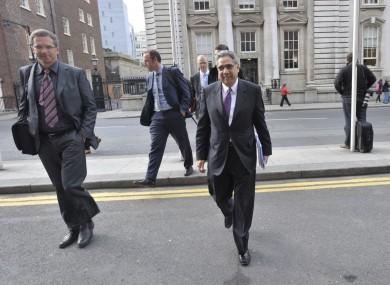Even the IMF doesn't believe this

The Troika of the European Commission, European Central Bank, and International Monetary Fund have passed Ireland with flying colours in their latest quarterly review. But this does not mean the end of Ireland's financial woes, writes Michael Taft.
Yes, we got a pat on the head. Yes, as Stephen Kinsella put it, there was a ‘nothing to see here, keep moving,’ quality to the EU-IMF’s performance report. And, yes, the IMF is forecasting that Ireland, under the current programme, won’t repair its finances by 2015, 2016 or potentially even by the end of the decade. But, hey, everything’s under control. Go back to sleep, Ireland.
You have a right to be confused. We have, after all, met all the EU-IMF performance targets. But, then, so did Greece and yet they found their deficit going out of control. How do you explain this? Easy; performance targets are not the same as fiscal targets. You design a programme to achieve x. You go out and do everything that’s in the programme (thus, the pat on the head). But you don’t achieve x. Why? Because the programme design is flawed from the outset. That is what’s happening in Ireland.
Let’s go through some numbers. The Government claims it will reduce the deficit to -2.8% of GDP by 2015, or -€5,035 million. Celebration in the streets – we have reached the Maastricht target, our public finances have been repaired, the markets embrace us to their bosom.
Except, the IMF says this won’t happen. The deficit will remain well below the Maastricht target at -4.4%, or -€8,000 million. We have more road to travel, more ‘tough’ decisions, beyond the ones we have to take in the current programme; more exhortations to spend, more ‘sacrifices’ to be made.
But in the trends, there is something more worrying – and something the ESRI highlighted last year. The IMF projects that in 2014 – the last year of fiscal consolidation – the deficit will stand at -4.9%. Everyone accepts that fiscal adjustments dampen growth. So once austerity is lifted, we should see GDP growth rising and the deficit falling. However, this may not be case.
In 2015 and 2016, the IMF projects the deficit will fall only marginally, down to -4.4% and then -4.2%. The ESRI projected that under moderate growth rates (averaging 3%) Ireland would fail to reduce the deficit to the Maastricht target by 2015 and 2020. That’s because growth rates will tail off in the latter half of the decade, following the post-recession lift.
The ESRI was working off the previous fiscal adjustments that Fianna Fail was pursuing before they doubled it prior to the last budget. However, such is the level of deflation that is being poured into the economy through spending cuts and tax increases on low-average income earners, that we won’t reach the ESRI’s moderate growth rate. The current Government is projecting average growth at 2.5%.
Of course, one could look at the IMF’s projections and say, “well, it’s only a percentage or two, what’s the problem, we’ll just front-load more deflationary policies”. That’s fine except that every time more growth-killing deflation is poured into the economy, the longer we extend the Maastricht target date (at the start of the recession, the Government projected we would reach Maastricht by 2011; now it’s 2015).
More front-loading, more austerity will reduce growth rates and, thus, undermine deficit reduction. It’s like being stuck in quicksand – we can run even harder, but we’ll just end up sinking.
It is in these numbers, however small they seem, that explain the following. Ministers have begun to say that we have turned the corner, and that the economy is back on the road to recovery. The EU-IMF have patted our head. Commentators are congratulating Irish fortitude compared to Greek irresponsibility. Everything would be alright if it weren’t for those other feckless Mediterraneans – the Spanish and Italians.
Yet, the Finance Minister is softening up public opinion by suggesting we may need more fiscal adjustments than is in the plan – €4 billion, rather €3.6 billion. And it’s only July. What are the odds on that adjustment rising the closer we get to budget day?
The reason is clear – the more austerity we pile on ourselves, the further away the goal of repairing our public finances.
And here’s a grim prospect. If the rule-of-thumb that the Department of Finance uses – that it takes €2 of fiscal adjustment to reduce the deficit by €1 – then we are looking at an additional €4 to €6 billion in spending cuts and tax increases up to 2015. And even then we still won’t reach the Maastricht target because growth will have been cut even more, creating tax revenue shortfalls and maintaining double-digit unemployment.
But don’t worry. The pats on the head will keep coming. And we’ll find someone else by then to blame.
Maybe the Belgians.
